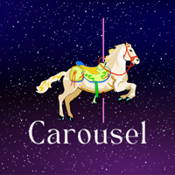
Overview
Synopsis
Richard Rodgers once wrote that of all the musicals he wrote, Carousel was his personal favorite. This American classic features some of Rodgers and Hammerstein's most iconic pieces, including “If I Loved You”, “Mister Snow”, “June Is Bustin Out All Over”, and the iconic “You’ll Never Walk Alone.” Carousel was Rodgers and Hammerstein’s second collaboration, and was adapted from Ferenc Molnar’s 1909 play Liliom. They transferred the Budapest setting of Liliom to the New England coastline, where Carousel takes place. The story tells of roguish carnival barker Billy Bigelow and mill worker Julie Jordan, both loners, who meet and fall in love. Their marriage ends up costing both their jobs, and things go downhill from there. Billy’s desperation makes him violent against those he loves most, and drives him to commit crimes in order to provide for his family. When Billy falls in with con-man Jigger Craigin, he ends up getting caught in the midst of an armed robbery and takes his own life. Billy is allowed to return to earth for one day 15 years later, and he encounters the daughter he never knew. Louise is a lonely, friendless teenager, her father's reputation having haunted her throughout her young life. Yet Billy is able to instill in both the child and her mother a sense of hope. Voted the best musical of the 20th century by Time Magazine, Rodger’s and Hammerstein’s Carousel is the classic American musical, spanning heaven and earth in its exploration of human frailty, resilience, and the power of forgiveness.
Show Information
Context
Rodgers and Hammerstein’s first collaboration on Oklahoma in 1943 was a massive success due to its social commentary and full integration of music, character building, and dance as plot-furthering devices. Oklahoma distinctly launched musical theater into a new stylistic era, and established high expectations for Rodgers and Hammerstein’s following projects. Carousel was Rodgers and Hammerstein’s second musical theater collaboration together. The musical opened on Broadway at the Majestic
to read the context for Carousel and to unlock other amazing theatre resources!Plot
PRELUDE
Carousel begins with a pantomime sequence performed during “The Carousel Waltz.” The sequence is set at an amusement park on the New England Coast and prominently features a merry-go-round, specifically named Mullin’s Carousel. At the beginning of the sequence, townspeople are seen enjoying the park’s attractions. A favorite attraction for many female characters is Billy Bigalow, the carousel’s barker. While working, Billy pays particular notice to Julie Jordan and allows her to skip
to read the plot for Carousel and to unlock other amazing theatre resources!Characters
| Name | Part Size | Gender | Vocal Part |
|---|---|---|---|
|
Lead |
Female |
Soprano |
|
|
Lead |
Male |
Baritone |
|
|
Lead |
Female |
Soprano |
|
|
Supporting |
Female |
Non-singer |
|
|
Supporting |
Male |
Non-singer |
|
|
Supporting |
Female |
Non-singer |
|
|
Supporting |
Female |
Mezzo-Soprano |
|
|
Supporting |
Male |
Tenor |
|
|
Supporting |
Male |
Baritone |
|
|
Featured |
Male |
Bass |
|
|
Featured |
Male |
Non-singer |
|
|
Featured |
Male |
Silent |
|
|
Featured |
Not Specified |
Non-singer |
|
|
Ensemble |
Not Specified |
|
Songs
Act One
Act Two
A song with an asterisk (*) before the title indicates a dance number.
Monologues
Scenes
Key Terms
A classical dance form used in theatre for expressive movement, storytelling, and interdisciplinary performance.
A non-literal theatrical scene representing a character's inner thoughts, fears, or desires, often surreal in style.
A period of artistic flourishing, often referring to 1940s-60s Broadway or English Renaissance theatre. This term plays a vital role in understanding theatrical structure and is commonly encountered in stagecraft or performance settings.
The “Golden Age Musical” refers to Broadway shows written roughly between the 1940s and 1960s, a period known for integrating songs, story, and character development. These musicals often balanced romance, comedy, and social themes with memorable melodies and large ensembles. Classics from this era continue to shape the foundation of modern musical theatre.
A recurring musical theme associated with a particular character, idea, or emotion. Frequently used in opera and musical theatre, leitmotifs help reinforce narrative continuity and emotional cues for the audience.
A dramatic genre with exaggerated characters and emotions, often including music to enhance moral and emotional stakes.
A production created to showcase the talents of a specific star performer, often tailored to their strengths.
Videos
Quizzes
Themes, Symbols & Motifs
Themes
Love and Redemption – At the heart of
to read about the themes, symbols and motifs from Carousel and to unlock other amazing theatre resources!Quote Analysis
*“If I loved you, time and again I would try to say /
to read our analysis of select quotes from Carousel and to unlock other amazing theatre resources!
